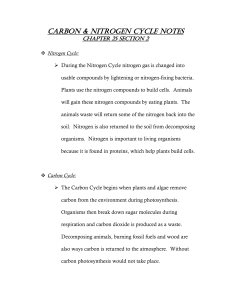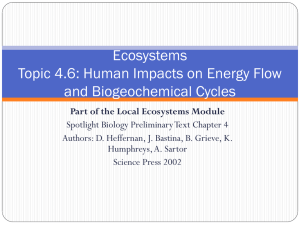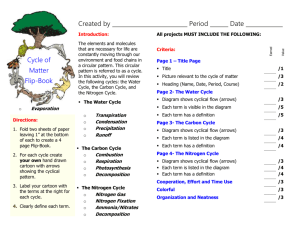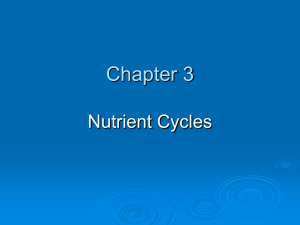Cycling WebQuest:
advertisement
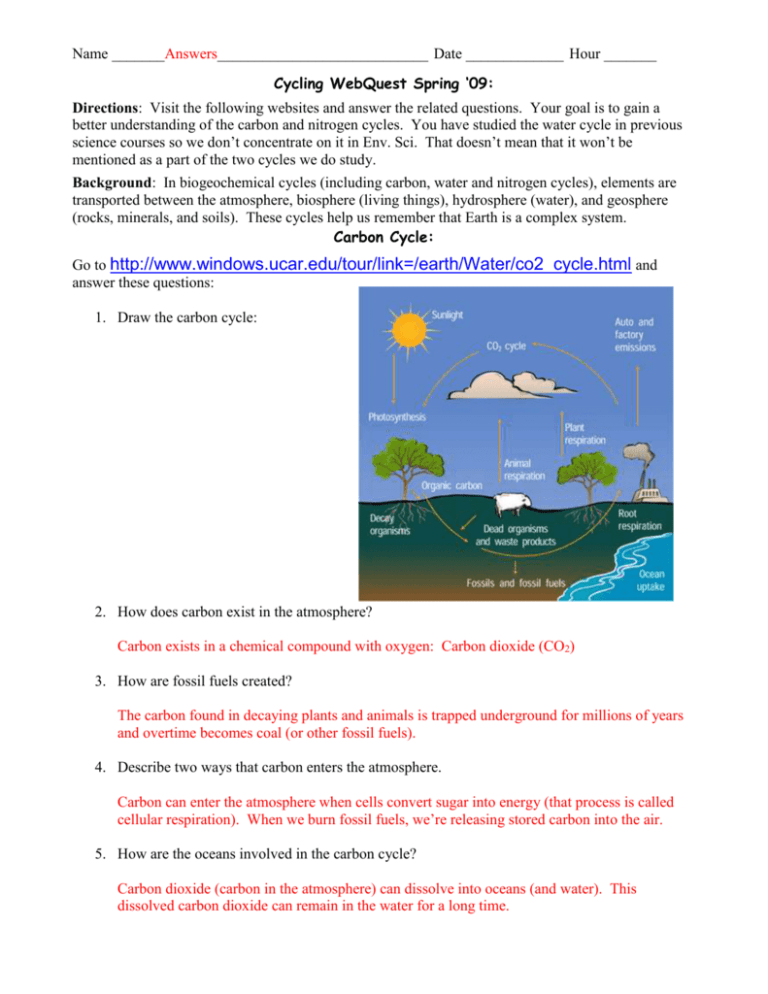
Name _______Answers____________________________ Date _____________ Hour _______ Cycling WebQuest Spring ‘09: Directions: Visit the following websites and answer the related questions. Your goal is to gain a better understanding of the carbon and nitrogen cycles. You have studied the water cycle in previous science courses so we don’t concentrate on it in Env. Sci. That doesn’t mean that it won’t be mentioned as a part of the two cycles we do study. Background: In biogeochemical cycles (including carbon, water and nitrogen cycles), elements are transported between the atmosphere, biosphere (living things), hydrosphere (water), and geosphere (rocks, minerals, and soils). These cycles help us remember that Earth is a complex system. Carbon Cycle: Go to http://www.windows.ucar.edu/tour/link=/earth/Water/co2_cycle.html and answer these questions: 1. Draw the carbon cycle: 2. How does carbon exist in the atmosphere? Carbon exists in a chemical compound with oxygen: Carbon dioxide (CO2) 3. How are fossil fuels created? The carbon found in decaying plants and animals is trapped underground for millions of years and overtime becomes coal (or other fossil fuels). 4. Describe two ways that carbon enters the atmosphere. Carbon can enter the atmosphere when cells convert sugar into energy (that process is called cellular respiration). When we burn fossil fuels, we’re releasing stored carbon into the air. 5. How are the oceans involved in the carbon cycle? Carbon dioxide (carbon in the atmosphere) can dissolve into oceans (and water). This dissolved carbon dioxide can remain in the water for a long time. 6. How is the temperature of the Earth partly controlled by carbon? Carbon dioxide is a greenhouse gas. Greenhouse gases are able to trap heat in the atmosphere and that keeps the Earth warmer. Higher levels of carbon dioxide in the atmosphere leads to warmer temperatures on Earth. 7. What role do rocks have within the carbon cycle? Over time, carbon can create rocks like limestone, dolomite, calcite, and marble. This carbon is then “trapped” within the rock for a long time. It can gradually be removed from the rock as water reacts with it (in, for example, the formation of a cave). Go to http://www.windows.ucar.edu/earth/climate/carbon_cycle.html to play the carbon cycle game. You are a carbon atom! 8. Where are you starting within the carbon cycle? You’re starting with the atmosphere. “Click to begin your journey” 9. How much of the atmosphere is made of carbon dioxide (CO2)? Carbon dioxide makes up 0.04% of the atmosphere. 10. By how much has CO2 increased in the atmosphere during the past 150 years? It has increased by 30% during the past 150 years. As you work through this game, take some notes about where you go as a carbon atom. Make sure you visit all reservoirs! The deep ocean Answers may vary since path taken may vary. accounts for more 11. Next stop = _________________________________________ than _65__ % of What did you learn? the Earth’s carbon. 12. Next stop = _________________________________________ What did you learn? How much carbon does the surface ocean absorb from the atmosphere each year? _90 gigatons ____ True or False: When plants die and decay, they bring carbon into soil. 13. Next stop = _________________________________________ What did you learn? 14. Next stop = _________________________________________ What did you learn? 15. Next stop = _________________________________________ What did you learn? True or False: Plants both absorb CO2 from the atmosphere and release it into the atmosphere. True or False: Phytoplankton are tiny plants and algae that float in the ocean and take up carbon dioxide as they grow. When carbon enters the deep ocean, how long does it stay there? _hundreds of years_ Nitrogen Cycle: Go to http://www.elmhurst.edu/~chm/onlcourse/chm110/outlines/nitrogencycle.html and answer these questions. 16. What are the two conditions under which nitrogen will react with oxygen? (In other words, what is necessary for nitrogen in the air to combine with oxygen?) Nitrogen will react with oxygen in conditions with really high temperatures and pressures. This might happen during lightning. Nitrogen will also combine with oxygen in combustion reactions. For example, this might happen when we’re burning fossil fuel in power plants or in vehicle internal combustion engines. 17. What are the two compounds that are formed when nitrogen combines with oxygen? NO and NO2 18. How does nitric acid (HNO3) form? Nitric acid forms when NO2 reacts with water. 19. Why is nitric acid (HNO3) important? Nitric acid can be used by plants to obtain the nitrogen they need. Go to: http://users.rcn.com/jkimball.ma.ultranet/BiologyPages/N/NitrogenCycle.html and answer these questions. 20. What percentage of the air we breathe is nitrogen? The air we breathe is 79% nitrogen. 21. Even though considerable nitrogen is available in the air, most plants do not use the nitrogen (N2) found in the air. Why not? Plants are not able to use nitrogen in this form. 22. In what compounds can plants use nitrogen? Plants can only use nitrogen when it has been converted or “fixed” into one of these compounds: NO3, NH3, or (NH2)2CO 23. How do animals get the nitrogen they need? Animals can only get nitrogen by eating plants or eating other animals (who got their nitrogen by eating plants). 24. Atmospheric nitrogen (N2) is pretty inert. This means that it does not easily break apart. When molecules do not break apart easily, it is difficult (or impossible) for organisms to use them as a nutrient source. As a result, nitrogen fixation is the term used to describe the process of breaking up N2. a. What is atmospheric fixation? In atmospheric fixation, the unusable nitrogen found in the atmosphere is converted into a form useable by plants. That process occurs under incredibly high temperatures (during lightning). The newly created compounds reach earth/soil by dissolving in water. This creates only a small percentage (5-8%) of all the nitrogen useable by plants. b. What is industrial fixation? [This is how artificial fertilizers are made.] In industrial fixation, nitrogen is converted to a useable form by a chemical reaction that takes nitrogen from the atmosphere and hydrogen from a fossil fuel in high heat to form nitrogen compounds that plants can use. c. What is biological fixation? (In your answer, describe the types of plants associated with the symbiotic relationship.) In biological fixation, a living organism (nitrogen-fixing bacteria) are able to convert atmospheric nitrogen into a nitrogen-containing compound that plants can use. These nitrogen-fixing bacteria live in a mutualistic relationship with legumes (bean-type plants). Go to: http://www.physicalgeography.net/fundamentals/9s.html and answer these questions. 25. Draw the nitrogen cycle. (Remember there are other diagrams on the previous websites.) If you’re not sure what a term means, look through the reading and links for help. 26. Why is nitrogen needed by plants and animals? Nitrogen is necessary for plants and animals because it helps produce amino acids, proteins and nucleic acids – these help cells function correctly and make up our DNA.




